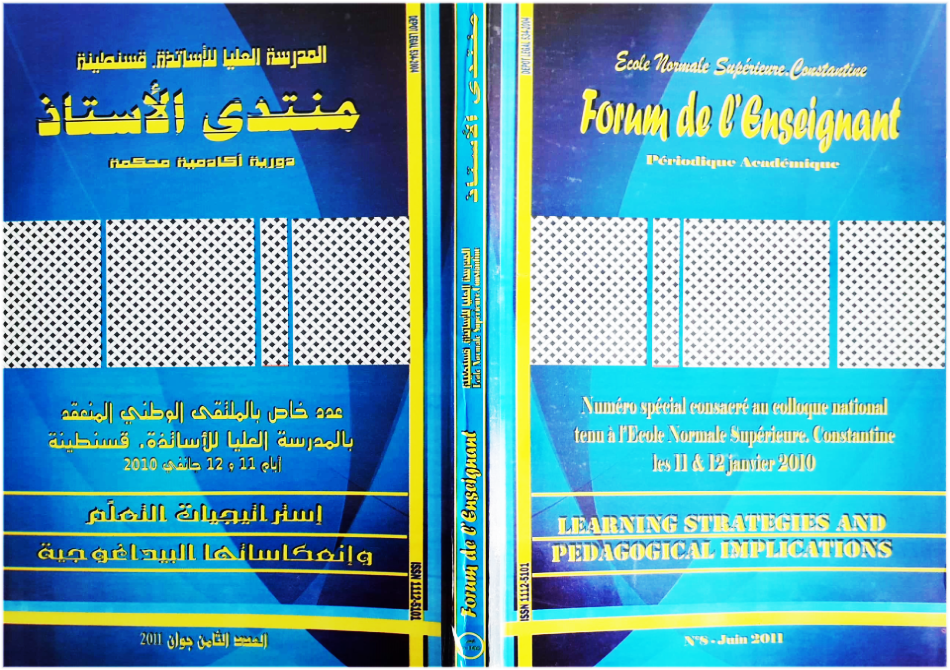Enhancing Automaticity in Middle School Textbooks
Résumé
Recent approaches in second or
foreign language teaching such as
the Competency-based Approach
seek to enhance automaticity
amongst learners. An examination
of Algerian Middle School English
textbooks Spotlight on English
reveals that their ultimate aim is to
promote automaticity through the
Competency- based Approach.
Automaticity in these textbooks is
said to be achieved through oral
interaction, negotiation, and
interpretation of oral and written
texts as well as their production.
More importantly, the syllabus puts
more emphasis on helping pupils
to use language creatively and not
merely reproductively. In this paper,
we will highlight the notion of
‘automaticity’ in recent SLA
literature, its implementation in the
Algerian school and its eventual
application amongst pupils
following the English textbooks in
the Middle School.
Téléchargements
Références
Anderson, J.R. (1992). Automaticity and the ACT theory. American Journal of Psychology.
: 165-180.
Arab et .al., (2004). Teacher’s Book, Middle School - Year three.
Bailey, N., Madden, C., and Krashen, S.D. 1974. Is there a ‘natural sequence’ in adult
second language learning? Language Learning, 24/2: 235-43. Reprinted in B. W. Robinett &
J.
Schachter 1983 (eds.), Second Language Learning, Contrastive Analysis, Error Analysis and
Related Aspects, (pp.316-325). Ann Arbor: The University of Michigan Press, 1983.
Batstone, Rob.1994a. Grammar. Oxford: OUP.
Brown, R. 1973. A first Language. Cambridge, Ma.: Harvard University Press.
DeKeyser, R.M. (2001). Automaticity and automatization. In P. Robinson (eds.): Cognition
and Second Language Instruction (pp-125-151). Cambridge: Cambridge University Press.
Dulay, H. and Burt, M. 1973. Should we teach children syntax? Language Learning, 23: 245-
Dulay, H. and Burt, M. 1974. Natural sequences in child second language acquisition.
Language Learning, 24: 37-53.
Dulay, H.; Burt, M. and Krashen, S. 1982. Language Two. Oxford: OUP
Ellis, Rod.1985. Understanding Second Language Acquisition. Oxford: OUP.
Ellis, Rod. 1992. Second Language Acquisition and Second Language Pedagogy.
Clevedon: Multilingual Matters Ltd.
Goldschneider, Jennifer M. and DeKeyser, Robert M. 2001. Explaining the “natural order
of L2 morpheme acquisition” in English: A meta-analysis of multiple determinants.
Language Learning, 51/1: 1-50.
Hedge, T. 2000. Teaching and Learning the Language Classroom. Oxford: Oxford University
Press.
Hatch, Evelyn and Wagner-Gough, Judy. 1976. Explaining sequence and variation in
second Language acquisition. Language Learning, special issue, 4: 39-57. Reprinted in B.W.
Robinett and J. Schachter (1983) eds., pp. 334-353.
Krashen, Stephen D.1981. Second Language Acquisition and Second Language Learning.
London: Printice Hall International.
Krashen, Stephen D. 1987. Principles and Practice in Second Language Acquisition. New York:
Printice Hall International.
Kuk, Linda and James, Banning. June, 2009. Student affairs preparation programs: a
competency based approach to assessment and outcomes. College Student Journal.
http:/findarticles.coms/p/search.qa=lindaKuk..
Johnson, Keith. 2001. An Introduction to Foreign Language Learning and Teaching. (2nd ed.
.
Jones, & Voorhees. (2002). Report of the National Postsecondary Education Cooperative
Working Group on Competency- Based Initiatives in Post Secondary Education (NPEC
Report).
Larsen-Freeman, Diane. 1976. An explanation for the morpheme acquisition order of
second language learners. Language Learning, 26: 125-134
Larsen-Freeman Diane. 1978. Implications of the morpheme studies for second language
acquisition. ILT (Review of Applied Linguistics), 39/40: 93-102. Reprinted in B. W. Robinett
and J. Schachter 1983 (eds.) , pp. 326-333. Logan, Gordan D.; Taylor, Stanley E. and
Etherton, Joseph L.1996. Attention in the acquisition and expression of automaticity.
Journal of Experimental Psychology: Learning, Memory, and Cognition, 22/3: 620-638.
McLaughlin, Barry. 1987. Theories of Second language Learning. London: Edward
Arnold.McLaughlin, Barry. 1990. Restructuring. Applied Linguistics, 11/2: 113-128.
Nunan, David. 1991. Language Teaching Methodology: A textbook for Teachers. London:
Printice Hall International.
Pienemann, Manfred. 1984. Psychological constraints on the teachability of languages.
Studies in Second Language Acquisition, 6: 186-214.
Pienemann, Manfred. 1989. Is language teachable? Psycholinguistic experiments and
hypotheses. Applied Linguistics, 10/1: 52-79.
Richards, Jack C. 1985. The content of language Teaching. Cambridge: CUP.
Robinson, Peter.1997. Generalisability and automaticity of second language learning
under implicit, incidental, enhanced, and instructed conditions. Studies in Second Language
Acquisition, 19: 223-247.
Sullivan, John and Burnett, Master. Apr 17, 2006. Recruiting Using a Competency-Based
Approach.http:/www.reproline.jhu.edu.english/8sw.htm.
Tschirner, Erwin. 1998. From lexicon to grammar. In J. Harper; M.G. Lively and M.K.
Williams (eds.), The Coming of Age of the Profession Issues and Emerging Ideas for the Teaching
of Foreign Languages, (pp. 113-128). New York: Heinle and Heinle Publishers.
Willis, Jane.1996. A Framework for Task-based Learning. Addison Wesley: Longman.





